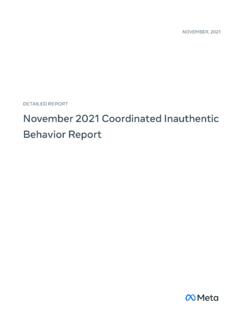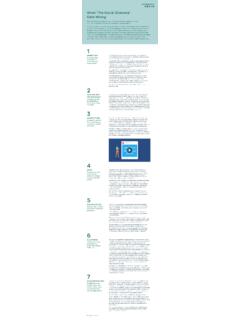Transcription of Su rve illa n ce -for-H ire In du stry Th re a t Re por t ...
1 December 2021 Threat Report on theSurveillance-for-Hire IndustryDecember 16, 2021By Mike Dvilyanski, Head of Cyber Espionage Investigations,David Agranovich, Director, Threat Disruption, andNathaniel Gleicher, Head of Security PolicyThreat Report on the Surveillance-for-Hire Industry2 Summary The global surveillance-for-hire industry targets people to collect intelligence, manipulateand compromise their devices and accounts across the internet. While these cyber mercenaries often claim that their services only target criminals andterrorists, our months-long investigation concluded that targeting is in fact indiscriminateand includes journalists, dissidents, critics of authoritarian regimes, families of oppositionmembers and human rights activists. We disabled seven entities who targeted people across the internet in over 100 countries;shared our findings with security researchers, other platforms and policymakers; issuedCease and Desist warnings; and also alerted people who we believe were targeted to helpthem strengthen the security of their Report on the Surveillance-for-Hire Industry3 This report is the result of our months-long investigation and disruption of seven entitiesproviding surveillance-for-hire services to target people across the internet, including journalistsand human rights activists.
2 It outlines the actions we took against them and includes ourresearch into what we call the surveillance chain phases of attack we ve observed over thecourse of our threat intelligence research. Our hope is to contribute to the broaderunderstanding of the harms this industry represents worldwide and call on the democraticgovernments to take further steps to help protect people and impose oversight on the sellers ofubiquitous is surveillance-for-hire and how does it work?In recent months, there has been an increased focus on NSO, the company behind the Pegasusspyware ( software used to enable surveillance) that weenforced against and suedin , it s important to realize that NSO is only one piece of a much broader global cybermercenary part of a separate effort,today, we are sharing our findings aboutseven entities that engaged in surveillance activity and we will continue to take action againstothers as we find global surveillance-for-hire industry targets people across the internet to collectintelligence, manipulate them into revealing information and compromise their devices andaccounts.
3 While cyber mercenaries often claim that their services and surveillanceware areintended to focus on criminals and terrorists, our investigation found they in fact regularlytargeted journalists, dissidents, critics of authoritarian regimes, families of opposition andhuman rights activists around the world. These companies are part of a sprawling industry thatprovides intrusive software tools and surveillance services indiscriminately to any customer regardless of who they target or the human rights abuses they might ecosystem works to provide powerful capabilities to its clients against victims who in mostcases have no way of knowing they are being targeted. In a sense, this industry "democratizes"these threats, making them available to government and non-government groups that otherwisewouldn't have these capabilities to cause harm. They in effect exponentially increase the supplyof threat actors in the Report on the Surveillance-for-Hire Industry4We observed three phases of targeting activity by these commercial players that make up their surveillance chain :Reconnaissance, Engagement, and phase informs thenext and often they repeat in cycles.
4 While some of these entities specialize in one particularstage of surveillance, others support the entire chain from start to finish. Although public debateso far has mainly focused on theexploitationphase,it s critical to disrupt the entire lifecycle ofthe attack because the earlier stages enable the later ones. If we can collectively tackle thisthreat earlier in the surveillance chain, it would help stop the harm before it gets to its final, mostserious stage of compromising people s devices and are more details and TTPs (the tactics, techniques, and procedures) characteristic for eachattack chain first stage of the surveillance chain is typically the least visible to the targets, who aresilently profiled by cyber mercenaries on behalf of their clients, often using software toautomate data collection from across the internet. Firms selling these capabilities typicallymarket themselves as web intelligence services to enable collection, retention, analysis andsearchability both targeted and at , these services and apps are designed to pull information about targets from all availableonline records.
5 They typically scrape and store data from public websites such as blogs, socialmedia, knowledge management platforms like Wikipedia and Wikidata, news media, forums and dark web sites. Surveillanceware often provides the benefit of obfuscating the origin of theactivity through unattributable of the primary means of collecting information on social media is the use of fake inauthentic assets can be used to search and view people s profiles, Friends, Likes andother publicly available information, join Groups and Events, and follow or friend targets. Theyare typically managed by the service provider for its clients, or operated by the customersthemselves through software provided by the surveillance-for-hire firm. The level ofsophistication of the fake accounts varies considerably across cyber mercenaries andtheir Report on the Surveillance-for-Hire Industry5 EngagementThis second phase of the surveillance chain is typically the most visible to its targets and mostcritical to spot to prevent compromise.
6 It is aimed at establishing contact with the targets orpeople close to them in an effort to build trust, solicit information, and trick them into clicking onlinks or downloading files (to enable the next exploitation phase).To do that, the operators typically rely on social engineering tactics and use fictitious personasto reach out to people via email, phone calls, text messages, or direct messages on social personas are typically tailored to each particular target to seem credible and avoid tippingpeople off to suspect malicious effortsare often prolonged and involve creatingbackstops for fake personas and organizations across multiple internet services so they appearmore legitimate and can withstand socialengineering aims can range fromobtaining sensitive information desired by the client to targeting the individual with malware toenable full-device digital surveillance. To achieve them, the operators may attempt to directpeople to more direct channels like voice or video calls or even in-person final stage of the surveillance chain manifests as what s commonly known as hacking forhire.
7 Providers may create phishing domains designed to trick targets into giving away theircredentials to sensitive accounts like email, social media, financial services, and corporatenetworks. We ve seen them spoof the domains of news organizations, telecom providers, banks,and URL-shortening services to deceive their enable the delivery of malicious payload, the operators may either use their owncustom-built exploits or acquire malicious tools from other vendors. The sophistication in toolingvaries significantly across this industry, ranging from off-the-shelf malware easily detected bymost anti-virus software to single-click or even zero-click exploit links sent to the ultimate goal is to enable device-level surveillance and monitoring of mobile phones orcomputers. At that point, depending on the exploit, the attacker can access any data onthe target s phone or computer, including passwords, cookies, access tokens, photos,videos, messages, address books, as well as silently activate the microphone, camera, andgeo-location Report on the Surveillance-for-Hire Industry6 Our investigative findings and the actions we tookAs a result of our months-long investigation, we took action against seven differentsurveillance-for-hire entities to disrupt their ability to use their digital infrastructure to abusesocial media platforms and enable surveillance of people across the internet.
8 They providedservices across all three phases of the surveillance chain that were used to indiscriminatelytarget people. These surveillance providers are based in China, Israel, India, and NorthMacedonia. They targeted people in over 100 countries around the world on behalf oftheir help disrupt these activities, we blocked related infrastructure, banned these entities fromour platform and issued Cease and Desist warnings, putting each of them on notice that theirtargeting of people has no place on our platform and is against our Community Standards. Wealso shared our findings with security researchers, other platforms, and policymakers so they toocan take appropriate action. We also notified people who we believe were targeted to help themtake steps to strengthen the security of their entities behind these surveillance operations are persistent, and we expect them to evolvetheir tactics. However, our detection systems and threat investigators, as well as other teams inthe broader security community keep improving to make it harder for them to remainundetected.
9 We will continue to share our findings when possible so people are aware of thethreats we are seeing and can take steps to strengthen the security of their Report on the Surveillance-for-Hire Industry7 Here is what we TechnologiesSurveillance chain phases: Reconnaissance, EngagementWe removed about 200 accounts which were operated by Cobwebs and its customersworldwide. This firm was founded in Israel with offices in the United States and sells access to itsplatform that enables reconnaissance across the internet, including Facebook, Instagram,WhatsApp, Twitter, Flickr, public websites and dark web sites. In addition to collectingThreat Report on the Surveillance-for-Hire Industry8information about their targets, the accounts used by Cobwebs customers also engaged insocial engineering to join closed communities and forums and trick people into revealingpersonal investigation identified customers in Bangladesh, Hong Kong, the United States, NewZealand, Mexico, Saudi Arabia, Poland, and other countries.
10 In addition to targeting related tolaw enforcement activities, we also observed frequent targeting of activists, oppositionpoliticians and government officials in Hong Kong and chain phases: Reconnaissance, EngagementWe removed about 100 accounts on Facebook and Instagram which were linked to Cognyte(formerly known as WebintPro) and its customers. This firm is based in Israel and sells access toits platform which enables managing fake accounts across social media platforms includingFacebook, Instagram, Twitter, YouTube, and VKontakte (VK), and other websites tosocial-engineer people and collect investigation identified customers in Israel, Serbia, Colombia, Kenya, Morocco, Mexico,Jordan, Thailand, and Indonesia. Their targets included journalists and politicians aroundthe CubeSurveillance chain phases: Reconnaissance, Engagement, ExploitationWe removed about 300 Facebook and Instagram accounts linked to Black Cube, an Israeli-basedfirm with offices in the UK, Israel and Spain.







